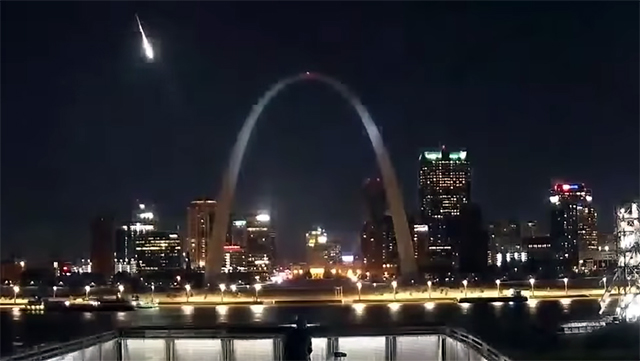Watch a Brilliant Fireball Flash Over St. Louis' Historic Arch (Video)
A bright fireball meteor streaked across the night sky above Missouri Monday (Nov. 11), passing over St. Louis' iconic Gateway Arch.
The giant flash of light came from a meteor traveling east to west across the state. It was seen over Missouri around 8:52 p.m. local time (0252 GMT), according to the American Meteor Society (AMS). The meteor was clearly visible in this stunning video from EarthCam's St. Louis location. You can see here on YouTube.
More than 120 sightings were reported to AMS. Reports came from multiple cities in Missouri, including St. Louis and Columbia, which are approximately 125 miles (200 kilometers) apart. The meteor is believed to have ended its flight somewhere near Wellsville, Missouri, according to AMS.
Related: Wow! Astronaut Captures Incredible View of 'Fireball' Meteor from Space (Video)
While the meteor was mostly seen in Missouri, observations were also reported from Indiana, Illinois, Kansas, Minnesota, Nevada, Nebraska, Oklahoma and Wisconsin. In addition to seeing a bright flash of light, many people also reported hearing a loud boom as the meteor streaked across the sky.
This video from AMS includes several views of the meteor that were captured by smart home security cameras in the area. The video also contains footage from EarthCam's St. Louis camera, which spotted the meteor passing behind the Gateway Arch monument, according to the statement from AMS.
Great video of a meteor this evening! Video courtesy of Tom Stolze! Awesome catch Tom! 🌠 https://t.co/tK5wO8zB0zNovember 12, 2019
The National Weather Service in St. Louis also shared a video of the meteor on Twitter and stated that it was unknown whether or not it touched down on Earth.
Breaking space news, the latest updates on rocket launches, skywatching events and more!
The sighting coincides with the peak of the Taurid meteor shower, which is known for its spectacular fireballs. The Taurid meteor shower is one of the year's longest, running from Oct. 20 to Nov. 30. The Taurids are most active during a one-week time frame extending from Nov. 5 through Nov. 12.
- Photos: Fireball Drops Meteorites On California
- How Often Do Big Fireballs Blaze Up in Earth's Sky?
- Caught Speeding: Illinois Patrol Cop Spies Blazing Fireball (Video)
Follow Samantha Mathewson @Sam_Ashley13. Follow us on Twitter @Spacedotcom and on Facebook.


Samantha Mathewson joined Space.com as an intern in the summer of 2016. She received a B.A. in Journalism and Environmental Science at the University of New Haven, in Connecticut. Previously, her work has been published in Nature World News. When not writing or reading about science, Samantha enjoys traveling to new places and taking photos! You can follow her on Twitter @Sam_Ashley13.

